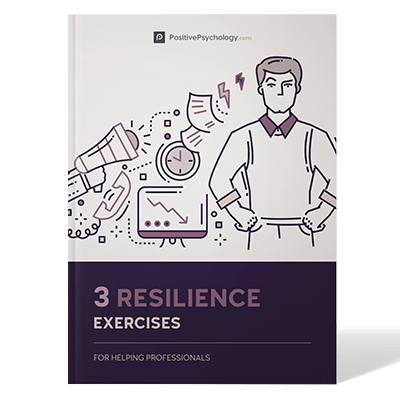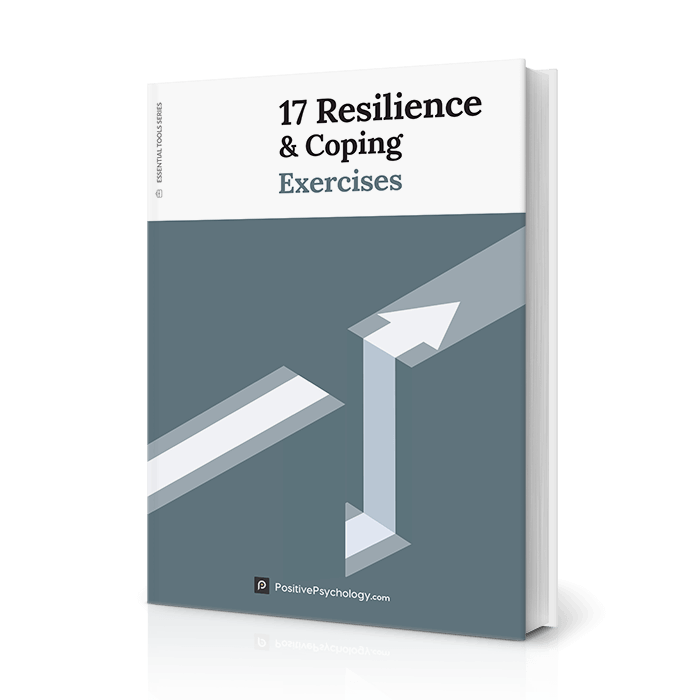Shame Resilience Theory: Advice From Brené Brown
 Shame is something we all experience, not just those unfortunate enough to have experienced trauma in their lives.
Shame is something we all experience, not just those unfortunate enough to have experienced trauma in their lives.
It is part of what it means to be human, influencing who we are and how we behave (Brown, 2007).
And yet most of us don’t want to talk about it; we fear and avoid shame because it leaves us feeling uncomfortable and vulnerable.
But that’s a problem. “Shame derives its power from being unspeakable,” writes researcher, psychology professor, and bestselling author Brené Brown (2015, p. 58). Ignored and avoided, it’s become a silent epidemic, spreading fear and encouraging negative behavior and thinking.
This article explores Brown’s influential work on shame and how to build the resilience needed to move through it.
Before you continue, we thought you might like to download our three Resilience Exercises for free. These engaging, science-based exercises will help you effectively deal with difficult circumstances and give you the tools to improve the resilience of your clients, students, or employees.
This Article Contains:
- What Is Shame Resilience Theory?
- Brené Brown’s Take on Shame and Vulnerability
- 4 Elements of Shame Resilience
- Overcoming and Dealing With Shame
- Therapy to Improve Shame Resilience
- Shame and Vulnerability: How to Build Resilience
- PositivePsychology.com’s Resilience Resources
- A Take-Home Message
- References
What Is Shame Resilience Theory?
Brené Brown has been researching shame for more than two decades. When she began, she was told that the subject was too difficult and that it would mark the end of her promising career. And yet, she persisted, and she was right to do so (Brown, 2006, 2007).
Her work has led to the following pivotal definition of shame. It is precise, yet widely applicable to the experiences of most of us (Brown, 2021, p. 137):
“Shame is the intensely painful feeling or experience of believing that we are flawed and therefore unworthy of love, belonging, and connection.”
In Atlas of the Heart, Brené Brown (2021) outlines the three pillars of shame, the result of years of research, her own and others.
- We all experience shame. It is universal. It is a primitive emotion shared by everyone unless they completely lack empathy or the capacity for human connection.
- It’s not easy to talk about shame. Even mentioning the word “shame” can lead to an experience of the emotion and evoke a strong sense of fear.
- Talking about shame brings a sense of control. That control gives us the strength to overcome our feelings and move forward with our lives.
In fact, when the topic of shame enters the conversation, we often find ourselves at a loss to know what it is, or if we understand it, then we most likely don’t want to talk about it (Brown, 2021).
So, if “shame is all about fear, what is its cause?” asks Brown (2007, p. 20).
Well, while it is fueled by our sense of being trapped within such feelings, it is also the result of unrealistic expectations (think of negative body image and the troubling impact of social media), worries regarding disconnection from others, and an impossible mix of contrary choices (“Be yourself. Be perfect. Look good. Be fun.”).
Listening to shame
Brown spoke about shame as an unspoken epidemic in her hugely popular TEDx video, Listening to Shame, offering the wonderful quote, “Life is about daring greatly, about being in the arena.”
The price of invulnerability: Brené Brown at TEDxKC
In another TEDx talk, The Price of Invulnerability, Brown describes how “vulnerability is absolutely at the core of fear, and anxiety, and shame, and very difficult emotions that we all experience” and provides a great lead-in to her theory of shame.
So how do we overcome fear and avoid becoming trapped in a web of shame?
Shame resilience theory
We are all capable of overcoming shame through building shame resilience. And according to Brown’s (2007) shame resilience theory (SRT), we can learn and develop the following:
- Capacity to recognize our experiences of shame
- Ability to move through shame constructively, maintaining our authenticity and growing from our experiences
- Stronger, more meaningful connections with people in our lives
As Brown (2007, p. 32) points out, shame resilience is not all or nothing, present or absent, but a continuum between shame (fear, blame, and disconnection) and empathy (courage, compassion, and connection).
To understand how to move away from shame and toward empathy, Brown revisited her interviews with women to gain a deeper understanding of their experiences.
The answers they gave recognized that “empathy creates a hostile environment for shame–it can’t survive” (Brown, 2007, p. 32). They went on to say that by sharing their experience of shame with others who expressed empathy, they were able to move forward. Empathy is central; we need to hear and feel someone saying:
I get it; I’ve felt the same way.
What you are feeling is normal. It’s OK
I understand what you are going through.
And according to Brown’s SRT, such empathetic words must be backed up by the listener being fully engaged and present when the speaker tells their story.
Brené Brown’s Take on Shame and Vulnerability

The following examples confirm that, most often, shame is associated with a past or a present that we had little or no control over (Brown, 2021, p. 136):
- “Shame is my husband leaving me for my next-door neighbor.”
- “Shame is infertility.”
- “Shame is flunking out of school. Twice.”
- “Shame is hiding the fact that I’m in recovery.”
- “Shame is bankruptcy.”
And the list goes on and on. And there will always be statements and beliefs that resonate with us, holding us in their grip. Shame and fear often walk together hand in hand (Brown, 2007).
The fire of shame is fed by silence, judgment, and secrecy; left to burn, it can damage all aspects of our lives. And yet, it doesn’t have to be this way; empathy has the potential to put out the flames, turn down the heat, and stop throwing fuel on the fire (Brown, 2021).
What does it mean to be vulnerable?
Vulnerability should not be confused or conflated with disclosure or emotional purging, writes Brown. She adds that believing that “vulnerability is weakness is believing that feeling is weakness” (Brown, 2018, p. 42). Instead, vulnerability is the cornerstone of courage, resilience, and problem-solving.
And for Brown (2007), recognizing vulnerability is far from a weakness; it is part of identifying and understanding our shame triggers. If I acknowledge that being a good parent is really important to who I am but also a vulnerability issue for me, it does not mean my shame around the issue will grow. Instead, we can use what we are feeling to seek out and utilize support – rather than letting it become a shame trigger.
The power of vulnerability
Brown’s TEDx talk The Power of Vulnerability has been watched by over 58 million people and offers excellent insight into the concept of vulnerability as the cornerstone of shame but also its potential for belonging, joy, and love.
4 Elements of Shame Resilience
Research by Brown (2007, 2021) and colleagues into SRT identified that those able to move through shame (toward empathy) all shared the following four elements of shame resilience.
Recognizing shame and understanding its triggers
We must learn to recognize physically when we are in the grip of shame so that we can name it and find our way through it.
Often obscured by other painful and difficult emotions, such as blame and fear, triggers can go unnoticed, causing us to react in inauthentic ways that only serve to exacerbate our shame.
Practicing critical awareness
The messages and expectations driving shame are likely unrealistic, unattainable, and not what you want to be or what others wish for you.
While awareness is about knowing that something exists, critical awareness is when you understand why it exists, how it works, and its impacts.
Reaching out
Are we truly connecting with and owning our story? If not, we can’t experience empathy.
Connection is a vital aspect of shame resilience, enabling us to feel valued, affirmed, and accepted. “When we feel worthless, rejected and unworthy of belonging, we feel shame” (Brown, 2007, p. 127).
Speaking shame
When we feel shame, we must learn to ask for what we need. Failing to speak, keeping it secret, and experiencing judgment are fanning the flame. After all, when we can’t find the right words or don’t have the right opportunity and audience, we are left alone with our fears; we shut down and accept our lot.
Shame is a trap we often fail to recognize as we enter or while in it; taken by surprise, we may not be sure how we got there or how to get out. The four elements above can help us become more aware of, better at avoiding, and more empowered to escape it (Brown, 2007).
Overcoming and Dealing With Shame

Shame thrives when we feel most alone – cut off, separate, and different from those closest to us. Shame happens in the gaps between people; when separation is removed or lessened, the feeling loses its power over us.
Using self-compassion to overcome shame
Kristin Neff’s research on self-compassion is helpful in learning how to better connect with others and reduce the opportunity for shame to take hold. Brown (2021) suggests using Neff’s three elements to improve self-compassion.
Practice self-kindness over self-judgment
Developing self-kindness includes becoming more understanding and forgiving with ourselves when we perceive our failures and inadequacies. Instead of being hard on ourselves, self-compassion involves recognizing we are imperfect and that the obstacles we face in life are inevitable.
Practice common humanity over isolation
Suffering and feelings of shame and personal inadequacy are universal among humans. We can benefit ourselves and those around us by recognizing that this is something we all go through – a shared experience.
Practice mindfulness rather than over-identification
A mindful state is nonjudgmental; it observes emotions and thoughts without trying to interrupt them or deny them. While we should not over-identify with the pain, we cannot ignore it; instead, we must show ourselves self-compassion.
Therapy to Improve Shame Resilience
Therapy can be helpful for anyone who identifies that shame is negatively impacting their own lives and those of others around them, or those who find themselves stuck and unable to move forward (Brown, 2007, 2021).
Specifically, therapy aligned with SRT helps clients interpret their reaction to shame, its triggers, and how they can connect better with others, reducing fear and increasing empathy.
In fact, “shame is a common emotion that contributes to many problems that bring clients in therapy,” and addressing shame in therapy can help with multiple psychological difficulties (Dearing & Tangney, 2011, p. 3).
Recent studies exploring the use of SRT in therapy have shown significant improvements in symptoms of depression following interventions to increase empathy and reduce shame (Alvarez, 2020).
Shame and Vulnerability: How to Build Resilience

- Learn to recognize and understand your shame triggers.
- Develop high levels of critical awareness about your web of shame.
- Be willing to reach out to others.
- Become able to speak about shame.
The following exercises can help address the four elements and teach us to move through shame. They can be self-administered or used with clients.
Learning to recognize our physical reaction to shame
Take some time to reflect on each of the following questions and gain a greater understanding of your physical reaction to shame (Brown, 2007).
- Where do you physically feel shame (for example, stomach, head, shoulders, etc.)?
- How does it feel (for example, butterflies in your stomach, tense shoulders, etc.)?
- How do you know when you are ashamed?
- What would shame taste like?
- What would shame smell like?
- What would shame sound like?
Learning to recognize shame will help you gain power over it.
Identifying shame triggers
Acknowledging our vulnerabilities can help us recognize our shame triggers (Brown, 2007). Make a list for each of the following questions:
- How would you like to be perceived (for example, strong, kind, resilient, etc.)?
- How would you NOT like to be perceived (for example, soft, weak, unforgiving, etc.)?
Reflect on the answers to the questions and ask yourself what situations or events may challenge each one and leave you feeling shame.
For those points you would not like to be identified with, ask yourself (modified from Brown, 2007):
- What does this perception mean to me?
- Why is it so unwanted?
- Where did this belief come from?
“When it comes to shame, understanding is a prerequisite for change,” says Brown (2007, p. 83).
Recognizing expectation
When we identify expectations (such as how we look, what we do, the partner we have chosen, etc.), it is vital to consider their origins. The following questions can be helpful (modified from Brown, 2007):
- What are the associated social-community expectations?
- Why do they exist?
- How do they work?
- How do they influence our society?
- Who really benefits from them?
Once we understand where such expectations have arisen from, we can recognize that they do not control us and reject them, freeing us from shame.
PositivePsychology.com’s Resilience Resources
We have many resources available for therapists providing support to individuals wanting to address emotional issues such as shame.
Why not download our free self-compassion pack and try out the powerful tools contained within? Some examples include:
- Applying the Yin Yang of Self-Compassion
Whereas many existing self-compassion therapeutic exercises help clients enact yin self-compassion, this tool helps clients explore and develop both yin and yang self-compassion. - Self-Care Vision board
This exercise helps clients creatively increase self-care and self-compassion using a self-care vision board.
Other free resources include:
- Guilt and Shame Emotions That Drive Depression
This worksheet helps break the cycle of shame and depression through reflection on guilty thoughts. - Letter of Self-compassion
Writing a letter of self-compassion can prompt us to be more forgiving and refocus our thinking on being kind to ourselves.
More extensive versions of the following tools are available with a subscription to the Positive Psychology Toolkit©, but they are described briefly below:
- Fierce Self-Compassion Break
This powerful exercise helps clients explore the difference between self-compassion that is tender and gentle versus self-compassion that is fierce and protective. It can help them manifest self-compassion in a way that is empowering, protective, and provides clarity in times of need. - Window of Tolerance
Therapeutic change often depends on widening what psychology refers to as the window of tolerance (WOT). We can have multiple WOTs throughout the day, depending on what we are doing and how we feel.
This exercise helps clients recognize their WOTs, the signs of when it begins to narrow, and how to stay within it.
If you’re looking for more science-based ways to help others overcome adversity, check out this collection of 17 validated resilience and coping exercises. Use them to help others recover from personal challenges and turn setbacks into opportunities for growth.
A Take-Home Message
The web of shame is something with which we should all be familiar. It doesn’t just arise from significant events, incidents, or failures; it exists in our day-to-day lives.
However, shame triggers are often invisible, found in the fabric of society, the workplace, education, and even our families. While not always intended to harm, they can lead to a sense of being trapped in shame and persistent feelings of fear associated with moving forward.
Brené Brown offers us a route out. When we can recognize the catalyst of our shame, create authentic connections built on empathy, and tell our story, we can emancipate ourselves. We can learn to redress the balance, from shame on one side to empathy on the other, showing ourselves and others kindness and compassion and allowing ourselves to become vulnerable.
Ultimately, empathy creates an environment that is hostile to shame, causing it annoyance and discomfort, rather than offering sustenance and room for growth. While we may not have control over the circumstances that led to these feelings, we can manage and overcome their effect on us.
Why not check out Brown’s TEDx videos embedded within the article and her books to better understand and overcome your own or your clients’ shame?
We hope you enjoyed reading this article. Don’t forget to download our three Resilience Exercises for free.
- Alvarez, D. V. (2020). Using shame resilience to decrease depressive symptoms in an adult intensive outpatient population. Perspectives in Psychiatric Care, 56(2), 363–370.
- Brown, B. (2006). Shame resilience theory: A grounded theory study on women and shame. Families in Society-The Journal of Contemporary Social Services, 87(1), 43–52.
- Brown, B. (2007). I thought it was just me (but it isn’t): Telling the truth about perfectionism, inadequacy, and power. Gotham Books.
- Brown, B. (2015). Daring greatly: How the courage to be vulnerable transforms the way we live, love, parent, and lead. Avery.
- Brown, B. (2018). Dare to lead brave work. Tough conversations. Whole hearts. Vermilion.
- Brown, B. (2021). Atlas of the heart. Vermilion.
- Dearing, R. L., & Tangney, J. (2011). Shame in the therapy hour. American Psychological Association.
Let us know your thoughts
Read other articles by their category
- Body & Brain (49)
- Coaching & Application (57)
- Compassion (26)
- Counseling (51)
- Emotional Intelligence (24)
- Gratitude (18)
- Grief & Bereavement (21)
- Happiness & SWB (40)
- Meaning & Values (26)
- Meditation (20)
- Mindfulness (45)
- Motivation & Goals (45)
- Optimism & Mindset (34)
- Positive CBT (28)
- Positive Communication (20)
- Positive Education (47)
- Positive Emotions (32)
- Positive Leadership (18)
- Positive Parenting (4)
- Positive Psychology (33)
- Positive Workplace (37)
- Productivity (16)
- Relationships (46)
- Resilience & Coping (36)
- Self Awareness (21)
- Self Esteem (38)
- Strengths & Virtues (31)
- Stress & Burnout Prevention (34)
- Theory & Books (46)
- Therapy Exercises (37)
- Types of Therapy (64)






What our readers think
BRENE BROWN’S works remain inspiring to me most especially because as an individual, I battle daily with shame but right now I believe, they will be a change.
It would be great if there were a pdf so I could print this off. Like a printer friendly version.
As a child, I knew I was ‘different’ but didn’t know what it was. My peers and even adults in my life, gave me the message that something was terribly wrong with me. I would come to see later, that it was being gay that gave those around me permission to bully me and ostracize me, even within my family of origin. Shame was my constant companion and praying it away, contemplating suicide daily, praying for cancer during adolescence, marrying a woman… didn’t take it away. In my late 30’s, I earned my BSW and then my MSW and have created a very successful private practice, using compassion for self as a foundation of the treatment approaches I use. Meeting Dr. Brown several years ago was a highlight of my career. Her work has wrapped so much understanding about my own experience and why what I offer as a clinician, resonates so much for those who are suffering. Thank you to Dr. Brown and all those who are using SRT!
Thank you for sharing your story, Jeff. It’s inspiring that you were able to overcome these hurdles and are now helping others with your work! 🙂
Thank u so much for this great work!pls can u lead me to other resilience theories am working on a study on resilience
Hi ThankGod,
For a good summary of theories on resilience, check out this paper by Ledesma (2014).
Hope this helps!
– Nicole | Community Manager
I want to know about the child counseling in various social and family problems in modern life. THANKS.
Hey,
As Brené’s research shows and a point which she emphasises is the vast difference between shame and guilt. Shame is “I am bad”, where guilt is “I did something bad”. Shame is focused on me as a person, and guilt is focused on behaviour. It’s very important to make that distinction.
Thank you for helping spread this important work!
Cheers